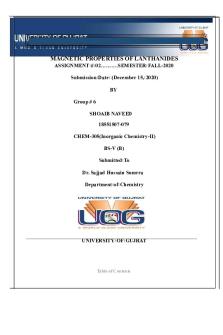Evans Method for magnetic susceptibility PDF

| Title | Evans Method for magnetic susceptibility |
|---|---|
| Author | Indranil Chakraborty |
| Course | Research Methods in Chemistry |
| Institution | Florida International University |
| Pages | 4 |
| File Size | 261.6 KB |
| File Type | |
| Total Downloads | 32 |
| Total Views | 129 |
Summary
Class notes for Evans method for magnetic susceptibility in solution for paramagnetic complexes. This is based in 1H NMR technique...
Description
The determination of magnetic susceptibility of substances in solution by Evans Method
The determination of magnetic susceptibility of substances in solution by NMR was published by Evans in 1959. Evans correlated and observed the difference in chemical shift of an inert reference compound (t-butanol) in the presence and absence of paramagnetic transition metal complexes with Equation 1.
Where cg is the mass susceptibility of the solute, Δf is the observed shift in the frequency of the reference compound, f is the frequency of the spectrometer, m is the mass of the substance per cm3 (mL)of solvent, c0 is the mass susceptibility of the solvent, d0 is the density of the solvent and ds is the density of the solution. The second and third terms may be dropped as they tend to cancel each other out or add more error. If the equation is also converted to a form appropriate for SI units, the equation becomes:
Where cm is the molar susceptibility of the solute (m3 mol-1), c is the concentration of the substance (mol dm-3), Δf is the observed shift in the frequency of the reference compound (Hz) and f is the frequency of the spectrometer (Hz).
In order to determine the difference in chemical shift of the reference compound caused by paramagnetic species, Evans used an NMR tube with a coaxial insert. The NMR tube contains a solution of the paramagnetic substance with 2% reference substance (t-butanol) and the coaxial insert contains only the solvent and reference substance.
In order to determine the electronic structure of a complex, we must determine the effective magnetic moment, μeff, using the following:
Where k is the Boltzmann constant, N0 is Avogadro’s number, μ0 is the permeability of a vacuum and μB is the Bohr magneton. Since the first term is a constant, the equation can be simplified as:
Where T is the temperature in Kelvin and cm is the molar susceptibility determined by Evans method. The theoretical magnetic moment can be determined using the number of unpaired electrons on the metal atom of a complex, n, using the following:
For example, a low spin Fe2+ complex is diamagnetic, thus n = 0 and the effective magnetic moment is 0 μB. Whereas a high spin Fe2+ complex is paramagnetic with four unpaired electrons, hence the effective magnetic moment would be expected to be 4.90 μB. Comparing the theoretical magnetic moment of their complex with their experimental value, we are able to determine whether their complex is high or low spin.
Two possible electronic structures for Mn(III)
Evans method is used to determine the magnetic moment and therefore electronic structure of [Mn(acac)3]. Accurately weigh approximately 5 mg of complex into an NMR tube and add 0.5 mL of solvent that has been made up with 10% t-butanol in CDCl3. Prepare a reference sample containing 0.5 mL of the 10% t-butanol in CDCl3 solution.
1
H-NMR spectrum of the reference sample (black) and the reference with [Mn(acac)3] (red) overlaid. The peaks are labelled in Hz.
Calculations (just an example) Molar susceptibility: Concentration of [Mn(acac)3] = 0.028 mol dm-3 Δf = 57.87 – 37.76 = 20.11 Hz f = 42,500,000 Hz
(MHz to Hz conversion, 1MHz = 1000000 Hz)
Using Equation 2, c m = 1.00 x 10-7 m3 mol-1. Effective magnetic moment: The molar susceptibility calculated above is used to determine the effective magnetic moment according to Equation 4. T = 294.16 K Using Equation 4, μeff = 4.33 μB.
The high spin complex has four unpaired electrons and the low spin complex has two. Use Equation 5 to estimate the expected effective magnetic moment (theoretical) for each electronic structure.
High spin, n = 4 μeff = 4.90 μB
Low spin, n = 2 μeff = 2.83 μB
The magnetic moment of the high spin complex is much closer to the experimental value, therefore it can be determined that the complex is high spin....
Similar Free PDFs

Chapter 1 Magnetic Circuits
- 61 Pages

Heather evans fincing
- 3 Pages

Plantas-alucinogenas-Evans-Schultes
- 161 Pages

Evans pka tables
- 6 Pages

Magnetic Fields Lab Report
- 9 Pages

MRI (Magnetic resonance imaging)
- 11 Pages

MAGNETIC LEVITATION TRAIN
- 27 Pages

Unit 10 Magnetic Circuit
- 5 Pages

Magnetic Flux IN PHYSICS
- 2 Pages
Popular Institutions
- Tinajero National High School - Annex
- Politeknik Caltex Riau
- Yokohama City University
- SGT University
- University of Al-Qadisiyah
- Divine Word College of Vigan
- Techniek College Rotterdam
- Universidade de Santiago
- Universiti Teknologi MARA Cawangan Johor Kampus Pasir Gudang
- Poltekkes Kemenkes Yogyakarta
- Baguio City National High School
- Colegio san marcos
- preparatoria uno
- Centro de Bachillerato Tecnológico Industrial y de Servicios No. 107
- Dalian Maritime University
- Quang Trung Secondary School
- Colegio Tecnológico en Informática
- Corporación Regional de Educación Superior
- Grupo CEDVA
- Dar Al Uloom University
- Centro de Estudios Preuniversitarios de la Universidad Nacional de Ingeniería
- 上智大学
- Aakash International School, Nuna Majara
- San Felipe Neri Catholic School
- Kang Chiao International School - New Taipei City
- Misamis Occidental National High School
- Institución Educativa Escuela Normal Juan Ladrilleros
- Kolehiyo ng Pantukan
- Batanes State College
- Instituto Continental
- Sekolah Menengah Kejuruan Kesehatan Kaltara (Tarakan)
- Colegio de La Inmaculada Concepcion - Cebu






